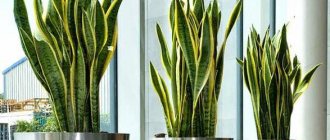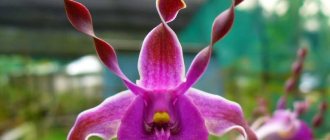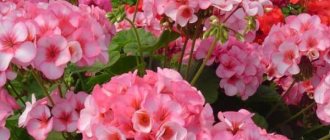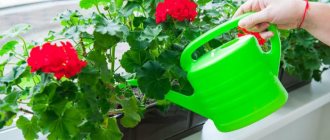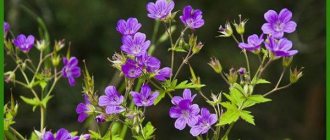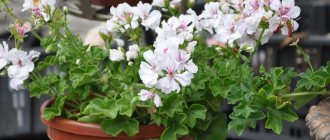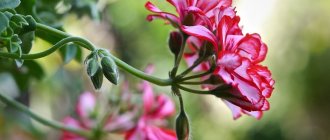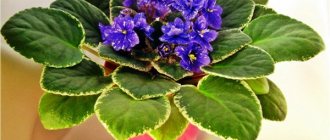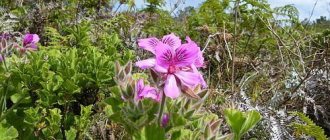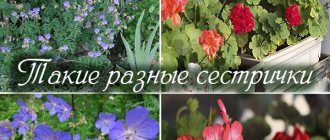Geranium is considered the most popular and famous plant in indoor floriculture. Beginning hobbyists appreciate it for its unpretentiousness and ease of reproduction. There are a huge number of different varieties. Geranium is an annual or perennial, reaching a height of fifty centimeters. The highlight of the plant is the leaves of a rich green hue, reminiscent of the color of young grass, and large bright flowers collected in inflorescences. The leaves emit a pleasant aroma of lemon and mint. In this article we will talk about the homeland of the plant, find out its scientific name and differences from another species - pelargonium.
Pelargonium care
As was said at the very beginning of the article, geranium is very undemanding in care, which is why gardeners love it. Care represents the fulfillment of the following conditions:
Watering
It all depends on the speed at which the top layer of soil dries out.
Geranium tolerates drought much better than excessive moisture, so it is important not to “flood” it, otherwise the bush will die
Typically watering is carried out about three times a week. By the way, it must be done carefully, trying not to get on the leaves of the plant itself. Spraying geraniums is also undesirable.
Landing location
Geranium is very photophilous, so its flowering directly depends on the amount of sunlight it receives. South-facing, well-lit windows are suitable for growing pelargonium.
Room temperature
This factor is not particularly important in the summer. In winter, the temperature should not fall below 10 0 C. The main thing is to protect the plant from drafts.
Loosening
It is recommended to carry out this operation periodically so that air flows to the roots and the earth does not turn into one monolithic piece. In order to loosen the soil, it is not at all necessary to have a special rake: you can use an old fork or stick.
Top dressing
Geraniums are fed during flowering and before flowering with phosphorus-containing fertilizers. Under no circumstances should you apply organic fertilizers; geraniums simply cannot tolerate them.
Bush formation
It involves rejuvenating pruning of an adult plant and the formation of young plants. In the first case, up to five buds are left on each shoot, from which new branches will appear in the future.
In the second case, the technique of pinching the tops with fingers is used for better tillering. All these operations are recommended to be carried out at the end of winter - beginning of spring.
Transfer
It is carried out not annually, but once every 2-3 years. It is best to replant with a clod of earth without exposing the roots.
Typically, this operation is performed when indoor pelargonium noticeably slows down its development. But this does not mean that the new pot has to be huge. You can increase its diameter by the thickness of your index finger.
Anthurium transplant
When replanting an anthurium, you need to take into account that if lush flowering is necessary, the pot should be small; a shallow but wide one is more suitable. The bottom must be covered with plenty of drainage. If it is necessary to propagate it by layering, you must use a large pot.
However, anthurium transplantation is done only when absolutely necessary, because it does not tolerate it well. Each time you change the flowerpot, the flower should be placed a little deeper than the previous level. If there are a large number of aerial roots or exposed underground roots, they should be covered with wet moss. Every year, only young plants should be replanted; adults should not be touched for 2-3 years.
Preparing the substrate for planting a flower
- Before preparing the land, select a container. You can use a pot that has been used. In this case, wash it the day before the scheduled procedure and disinfect it.
- At the next stage, a drainage layer is placed in the pot. It is sold in the store. In principle, you don’t have to buy it, but use pebbles, polystyrene foam, ceramic shards or broken bricks for drainage. If in the future they will water with hard tap water, put pieces of dried pine bark at the bottom. It will acidify the soil and remove excess moisture from it.
- 1/5-1/4 of the pot’s volume is allocated to the drainage layer. Then they put the soil. If you prepare it yourself, take the following components: turf, humus, sand (8:2:1). It is advisable to sprinkle it after transshipment of the transplanted plant, trying to remove all voids.
- All that remains is to water the geranium with settled water and wait for the excess to drain into the pan.
Which soil to choose
For successful cultivation, you should know what anthurium loves, the plant’s homeland and the necessary soil composition for a given flower. When preparing the soil with your own hands, you must remember that anthurium comes from tropical forests and is an epiphyte plant. The right soil is, one might say, 50% of success in growing. Soil of various compositions is currently presented in a large assortment in specialized stores. If there is only one plant, this is very convenient. Therefore, it needs light, breathable soil with good moisture permeability. The medium should be made acidic or slightly acidic. The normal ratio of soil components for anthurium is as follows:
- 2 parts humus;
- 1 part leaf soil;
- 1 part peat;
- 0.5 parts sand.
All constituent ingredients must be fully calcined in a stove or oven (separately from each other) to prevent the development of various bacterial or fungal diseases. To improve throughput, you can add a special composition for orchids or various organic materials to this mixture:
- walnut or coconut shells;
- cones;
- pine bark;
- charcoal;
- expanded clay
Their total content should be 15% of the total amount of soil mixture. These materials improve the soil structure, allow the root system to breathe and prevent moisture stagnation, and this, in turn, is one of the most important conditions required for anthurium at home. The plant suffers when planted in poor-quality soil. Leaves may turn yellow due to lack of air in the root system and too heavy soil structure.
Problems when growing a flower
- yellowing and falling of the lower leaves. Reason: lack of lighting, improper watering. Lack of sunlight causes leaves to turn pale. Drought causes the tips of the leaves to dry out, and excessive moisture causes them to rot. If this happens, the conditions of detention are adjusted: the plant is given additional light or watering is adjusted;
- redness of the leaf margins. Reason: frozen. Solution: move to a warmer room;
- lack of flowering. Reason: insufficient lighting or low temperatures. Solution: adjustment of conditions of detention;
- disease (gray rot, root rot) or exposure to pests: nematodes, aphids, whiteflies and mites. To avoid the development of diseases, it is necessary to ensure the correct conditions of detention.
Care and cultivation
Growing indoor geraniums is not difficult; they love warmth and sunny color. It is recommended to add fertilizers, mainly phosphorus, to the soil. Loves abundant watering; with a small amount of water and sunny color, the flowers will be very few and small in size. Geranium does not like stagnant water, so it is necessary to have holes and drainage in the pot.
To propagate geraniums, you can use the cutting method.
In summer, the flower can be taken outside, but preferably in a lighted and sunny area. The plant is resistant to diseases and insect pests. This is due to the presence of essential oils, which are harmful to many insects. It is recommended to promptly remove wilted flowers and yellowed leaves.
Pelargoniums are propagated by cuttings; to do this, the tips of the shoots and growth are cut off. The height and shape of the plant is formed by pruning; all parts can then be used to create cuttings. Then the cuttings are placed in a glass or jar of water until roots appear. The soil for planting should be loose and soft. Planted cuttings take root within 2-3 weeks. All seedlings take root in 25 days.
During the period of transplanting and rooting seedlings, it is necessary not to over-moisten the soil, otherwise the seedlings may die. Another method of propagation is by seeds. But it is more complicated and requires skill and experience from the gardener. Seeds are planted in loose soil to a depth of 1.5 cm. Water generously and keep the container in a dark place. Plants planted in this way in the spring are able to bloom by mid-summer.
When grown, geranium is unpretentious to the composition of the soil, but accepts watering well, and the pot must be equipped with drainage. When replanting, garden soil or any soil mixture can be suitable. It should be remembered that the flower will grow most comfortably in small pots; it is better not to choose spacious ones. For good growth, you can add a little peat to the ground.
Geranium is considered the most popular and famous plant
in indoor floriculture. Beginning hobbyists appreciate it for its unpretentiousness and ease of reproduction. There are a huge number of different varieties. Geranium is an annual or perennial, reaching a height of fifty centimeters. The highlight of the plant is the leaves of a rich green hue, reminiscent of the color of young grass, and large bright flowers collected in inflorescences. The leaves emit a pleasant aroma of lemon and mint. In this article we will talk about the homeland of the plant, find out its scientific name and differences from another species - pelargonium.
Where are you from?
First, let's figure out where this houseplant comes from. Found in the wild in New Zealand, Australia, California and Madagascar
. The plant is native to India and South Africa. It was from these regions that the plant came to European countries. One day, sailors who found themselves in South Africa became interested in an interesting plant with bright inflorescences. The British brought the plant to Great Britain, where breeders began to develop new varieties.
They began to decorate houses and gardens with it as soon as it arrived in Europe. Basically, this plant could be seen in the homes of nobles. Ladies of those times fell in love with the beauty and decorated their outfits with her, decorating headdresses and the neckline of luxurious dresses.
When did it come to Russia?
Rustenia arrived in Russia in the eighteenth and nineteenth centuries and immediately gained wide popularity among aristocrats. They began to decorate their luxurious houses with an unusual flower. Some species were never domesticated by humans; they spread into the wild, settling in meadows, swampy areas, and forest areas, persistently fighting unfavorable weather conditions.
Reproduction
All types of geranium reproduce in 2 ways:
- vegetative;
- seed.
Usually, when flowering, geranium seeds are scattered over long distances. If you are going to grow geranium from seeds at home, it is better to do this in March or April, and later do picking and planting in pots.
You can buy seeds in stores; their seedlings grow without any problems and produce a large number of seedlings. You can also wait for your indoor geraniums to bloom and sow the seeds that have already been collected from them. But it is necessary to take into account that with such sowing, certain hybrid varieties of geranium lose the properties of the mother plant.
It is usually recommended to sow geranium seeds in a container with moist soil to a depth of 2-2.5 cm. After this, you can even spray the sowing with a solution of potassium permanganate from a spray bottle to prevent various diseases, and then cover it with glass. It is necessary to constantly moisten the planting and maintain the temperature at 18-22 ºC. After germination, the glass must be removed and the temperature reduced to 16-20 ºC. Within a month or a month and a half, the seedlings will have leaves, which means they can be planted in pots.
In garden conditions, it is better to sow geranium as a ready-made bush, for example, after 2 years of growing from seeds. In this case, it is advisable to plant the bushes at a distance of 30-40 cm from each other. Geranium is easily propagated by division - by separating the rhizomes from the main bush. This method of propagation can be carried out in the spring, before the shoots grow leaves.
But the end of summer is the most favorable way for division, since during this period the plant is at rest
At the same time, you need to pay attention to the renewal buds - they must be in good condition. Such bushes without division usually live for about 10-15 years, which is their peculiarity
They decorate the flower garden for a long time until dead parts appear in the center. After this, the geranium can be divided and planted in newer soil.
Geraniums can also be propagated using cuttings. This process is the most labor-intensive of all, but if used correctly, you can get more than 10 finished plants from one well-developed bush.
- To do this, you need to prepare several containers with clean water, which must stand for at least 3 days.
- After this, carefully cut off branches 4-6 cm long, without flowers, with 2-3 leaves, and carefully place them in water. In this case, the cuttings should be immersed in water no more than halfway.
- Within 10-12 days, the cuttings can already take root, after which they can be transplanted into pots with prepared soil.
You can also plant freshly cut cuttings in soil with a pre-prepared substrate. You can purchase it at a specialty store or prepare it yourself. The pots should be equipped with a special drainage drain on the bottom, and the cuttings themselves should be planted so that 2/3 of the stem remains outside. It is not necessary to strengthen the cuttings in any additional ways or create a greenhouse effect for them. The indicator of successful planting will be the first leaves of the plant.
Important! The most favorable period for growing geraniums is the time of spring pruning. It is the cut stems that will become the material for seedlings.
We invite you to watch a video about planting geranium seeds:
We invite you to watch a video about cutting geraniums:
Varieties of geranium
Forest geranium grows in the wild.
Real geraniums have differences from indoor plants; they live in open ground and easily tolerate winter. Popular colors of geraniums are white, purple, blue and violet. The main types of geranium found in Russia:
meadow;
swamp;
blood;
Central European;
Southern European.
The special shape of the seeds determined the name of these plants. It resembles the head of a crane, and the Latin name “geranium” corresponds to it. Therefore, in everyday life among domestic gardeners and abroad, the plant is called crane grass.
The number of species, including not only flowers, but also herbs and subshrubs, is about 400 varieties worldwide. And pelargonium-geraniums, native to South Africa, number about 200 species. Garden varieties of geraniums are widely used for growing in flower beds or in the country. The most popular ones for growing at home are white and pink geraniums.
There are many varieties of fragrant geranium, some with the scent of lemon, wormwood, and almond. But plants with a pleasant aroma have one drawback - a small number of dull flowers. But their leaves are beautiful and large.
White geranium is most popular among indoor plant lovers.
White geranium is beautiful and unpretentious to growing conditions. The most popular and world-famous variety is Royal. Other types of white are destiny (translated as fate or destiny). The flower is a small shrub with a woody shoot, reaching a height of just over half a meter. Its leaves are large, with jagged edges; the flowers are bright, up to 5 cm in size. One stalk can have up to 20 flowers with 5 petals.
A beautiful and popular plant is rose geranium. Pink, red and white are varieties of pelargonium domesticum, only different in color. Plants are often single-shoot, with beautiful velvety leaves and bright flowers. The most beautiful varieties of this species are rightfully considered Symphony and the large-flowered variety Enzette Perle. It is distinguished by long and abundant flowering, subject to simple care rules.
Description
It’s worth starting with what can generally be called a cactus. You yourself most likely know that the characteristic thorny plant can theoretically take on completely different forms. Considering the confusion that sometimes occurs in biology, it is not surprising if some species that are commonly considered cacti are not actually cacti, and vice versa. So, according to the modern biological classification, cacti or cactaceae are a whole family of plants classified as Carnationaceae, the approximate number of species in total reaches about two thousand.
Interestingly, the word “cactus” is of ancient Greek origin, although, looking ahead, these plants do not come from Greece at all. The ancient Greeks used this word to call a certain plant that has not reached our times - at least modern scientists cannot answer what is meant by this term. Until the 18th century, what we now call cacti were called melocacti. Only in the classification of the famous Swedish scientist Carl Linnaeus did these plants receive their modern name.
Now let's figure out what is a cactus and what is not. It is wrong to confuse the concepts of cactus and succulent - the former necessarily refer to the latter, but the latter are a broader concept, that is, they may include other plants. Cacti, like all other succulents, have special tissues in their structure that allow them to store water for a long time. Actually, cacti are distinguished by areoles - special lateral buds from which spines or hairs grow. In a real cactus, both the flower and the fruit are, as it were, a continuation of the tissues of the stem; both organs are equipped with the above-mentioned areoles. Biologists identify at least a dozen more traits that are characteristic only of this family, but it is almost impossible for an ignorant person to see and evaluate them without the appropriate instruments.
If you can mistakenly call many prickly plants a cactus, which in fact are not classified as such, then sometimes you can completely fail to recognize a representative of cacti in green spaces that are in no way similar to the typical indoor version. Suffice it to say that a cactus (from a biological, not a philistine point of view) can turn out to be a deciduous bush and even a small tree. Or it can consist of almost one root with a barely noticeable above-ground part. The sizes, accordingly, can vary dramatically - there are tiny specimens several centimeters in diameter, but in American films you have most likely seen multi-meter branched cacti weighing several tons. Naturally, all this diversity is not grown at home - only those species that meet two basic requirements are usually chosen as indoor plants: they must be pretty and relatively small. Moreover, everything also depends on the region - in some countries species that are practically unknown in our country can be grown on a large scale.
Indoor plants and their homeland - the tropics
The tropics are located in the equatorial zone. The most common tropical landscape is evergreen forest, called jungle. The climate of the tropical zone is characterized by slight fluctuations in year-round temperature, a large amount of moisture both in the air and in loose fertile soil. Plants found in the jungle have different relationships to sunlight. This is explained by their multi-tiered nature in the tropical forest, where there is always partial shade under the dense crowns of trees. Plants from the tropics are moisture-loving, shade-tolerant, preferring loose, fertile soil. They need to be fed frequently and, in most cases, shaded from the sun.
Article on the topic: How to grow cyclamen from seeds
Composition of soil for geraniums at home, features of choosing the size of the pot
Geraniums are planted in moderately nutritious soil, neutral or slightly sour. Heavily fertilized soil in a pot for home pelargonium will result in leaves growing abundantly without flowering. Planting pelargonium in light garden soil with river sand and peat is an ideal option for a potted plant at home. The same soil mixture is suitable for sowing, and it is better to plant cuttings in a mixture of peat and sand (preferably spilled with a weak solution of potassium permanganate) or perlite.
There must be drainage at the bottom of the pot, for example, pebbles. This prevents water stagnation and root rotting. The size of the pot is selected according to the volume of the root system. The larger the container for the plant, the more powerful the bush grows, and as a result, it will bloom less. In a small pot, pelargonium can bloom well and for a long time. Several rooted cuttings can be planted in a large container. The plant needs to be replanted at the moment when the roots have mastered the entire provided volume.
You can grow pelargonium at home in plastic or clay pots. The second option is preferable, since in synthetic containers you will have to water it very carefully and often loosen it. The soil dries slowly in them, they do not allow water and air to pass through. Every year you need to replace the top layer of soil in pots with a new one, and in the second year it is better to replant homemade pelargonium.
How to distinguish two flowers?
A geranium flower has five or eight petals. Most often, single flowers bloom, but in some varieties they are collected in inflorescences. Pelargonium growing at home has an unusual corolla structure: the upper petals are larger than the three lower petals, resulting in an irregular shape of this part of the flower. Pelargonium flowers produce large inflorescences.
Geranium has a wide palette of shades in which flowers can be painted, except for scarlet, and pelargonium flowers never bear colors with blue notes.
Geranium is considered a garden plant that has gained great popularity among gardeners.
The most common varieties are “Georgian”, “Oxford”, and “magnificent”. Pelargonium is loved by home gardeners; it blooms flowers throughout the year. In the summer, it can be placed on a balcony or veranda, but in winter it must be returned indoors.
Flowers are often confused, believing that they are the same plant. However, these two flowers are completely different plants with fundamental differences, so you need to be able to distinguish them from each other.
Many gardeners are confident that they grow geraniums on their windowsills. However, only a few people know that the houseplant is called pelargonium (and this is not the same thing). In this article we will tell you how geranium differs from pelargonium.
Although geranium and pelargonium are not usually distinguished, from a scientific point of view, they are completely different plants. How did it happen that people believed that two different flowers were the same thing? The fact is that in the 18th century, the scientist Carl Linnaeus, while developing his classification of plants, mistakenly classified both of these flowers as one species, and it was his classification that flower growers accepted. But another scientist, who presented his classification around the same time, came to the conclusion that pelargonium and geranium are not the same thing, and it was this approach that appealed to the scientific community. Thus, some people mistakenly call a plant with a completely different name geranium.
So, the scientific name of geranium is Geranium, and those flowers that are usually grown indoors are called Pelargonium. These plants not only have a different name, they even differ in appearance, since they belong to different biological species.
general description
The number of geranium varieties today is approaching 400. Flowers adapted for life at home are unpretentious and can delight you with their flowering throughout the year.
The leaf blades are green, velvety, asymmetrically dissected, in most cases palmately divided or palmately lobed; varieties with 3-5 pinnate leaves are less common.
The flowers are collected in inflorescences and consist of five round, almost identical in size corolla petals. The color can be pink, white, purple, blue, as well as purple and red.
The fruits are a box with preserved sepals, visually reminiscent of a crane's beak; it opens in an unusual way - from the bottom to the top.
Many years ago, the healing properties of geranium were discovered; its leaves helped to heal open wounds and abscesses due to their strong anti-inflammatory and regenerative effects.
In its historical homeland, the flower was often used to quickly treat runny noses and migraines; in addition, the plant had a calming effect.
History of the origin of geranium
In its natural habitat, this plant can be found in South Africa. The culture prefers to grow in hot and sunny climates. Despite the fact that geranium is a heat-loving plant, it has easily adapted to the territory of the European continent.
The history of growing this flower dates back to the 16th century. It was at that time that trade with African countries developed. For Russia, this flower became known after Peter I traveled through Europe. The Dutch architects brought with them several bushes of indoor flowers, including geraniums.
The origin of this name is associated with the prophet Mohammed. Once upon a time, geranium was a simple weed that no one paid attention to. But when the prophet descended from heaven to earth, and his cloak was wet from sweat, he threw it onto the grass. Geranium wrapped the cloak closer to the sun so that the moisture would evaporate from it as quickly as possible. The Prophet Mohammed saw this and thanked the culture, giving it an unforgettable aroma and a luxurious umbrella of inflorescences.
The meaning of the flower could be determined by the shade of the inflorescences. For example, pink geranium attracted family well-being and love, white geranium attracted childbirth, and red geranium protected from evil spirits and evil spirits. The petals of this plant can also attract a husband to the house, helping to build family relationships. For this purpose, young unmarried girls carried dried flowers in a linen bag with them everywhere. In the family, this plant helped women get rid of their husband’s drunkenness, and also returned him to the family.
Poems were written about geranium; famous classics mentioned it in various stories. Plants were grown for healing and to decorate the garden and home. Some varieties can adapt to outdoor conditions, while others prefer to grow only indoors. However, they all respond gratefully to the care of their owner.
Country of origin of indoor geranium
South Africa has presented flower growers with many unique plants, and pelargonium was no exception. The culture was brought to Europe in the early 17th century by sailors exploring the coast of the Cape of Good Hope.
Wild specimens of geranium are part of the Cape flora, represented by a wide variety of clivias, chlorophytums, sansevierias and other local “inhabitants”.
Geranium grows mainly in African savannas on rocky slopes, rock outcrops and sandy soils.
This choice of growing area affected the love of indoor pelargonium for warmth and the characteristics of the soil, which should be moderately nutritious and loose.
Pelargonium came to Russia in the 18th and 19th centuries, where the bright inflorescences instantly made the culture popular.
The plant was kept in the estates of aristocrats, but later the unpretentious flower spread to many Russian houses. Certain varieties of geranium have settled in the wild, becoming an adornment of fields and forests.
Breeding work to develop new varieties of indoor geranium began simultaneously with the emergence of interest in the flower and continues to this day.
As a result of the work of hybridizers, many specimens adapted to the peculiarities of our climate were obtained, the decorativeness of which reached a completely new level.
Double, semi-double and simple inflorescences of snow-white, rich scarlet, pink, lilac, coral and almost black colors have become the main advantage of the varieties.
Spreading
Few gardeners think about where geranium grows in nature. Wild meadow varieties live in temperate latitudes. The optimal climate for the plant is considered to be Northern. Currently, the plant lives almost everywhere. In Russia, wild varieties are represented mainly by forest and meadow geraniums.
The culture is widespread throughout the European part, except for the Far Eastern coast and the Far North.
In its natural environment, the plant can be found in the form of small shrubs, among other meadow and forest crops. Geranium grows in dense meadows and ravines, and also grows along forest roads. Often shrubs form small thickets.
The most beautiful blooming indoor flowers photos and names
In nature, there are many domestic crops grown on windowsills. This section presents flowers with bright inflorescences that do not stop blooming almost all year round.
Begonia
Not a capricious houseplant that blooms all year round. Begonia blooms with lush inflorescences all year round with proper care. The flower loves light and is undemanding to soil and temperature conditions. In the summer it is taken out onto the loggia without harm to health. Transplanted by cuttings. To make the crop lush, it is pruned.
Abutilone
Thanks to its leaves, the home flower received the name “indoor maple” among gardeners. The plant is not whimsical; it requires constant, careful watering and good daylight. The best soil for flowers is deciduous humus with sand, turf, and mature manure. For abundant flowering, abuliton is fed with superphosphates and saltpeter. Will require pruning in spring. Propagated by cuttings.
Hibiscus
A picky indoor shrub that grows in houses up to 2 m. It blooms from spring to autumn with large flowers of whitish, bright red, and pink colors. The plant is sun-loving. In summer it requires good watering. In winter, the culture is kept at a temperature of 16-17C. Propagated by cuttings. Suitable soil: humus/peat, turf, a little sand. In spring, the flower is pruned to form a bush shape.
Anthurium
The plant is divided into decorative deciduous crops and flowering ones. Blooms in light red, crimson, red. Loves light and thermometer division not lower than 18C, moderate watering. Flowers do not mind irrigation. They are planted by cuttings and cutting off the side stems. The substrate must be drained.
Clivia
The indoor flower is characterized by dark green leaves. During flowering, a long stalk with yellow-orange buds is formed on it. The plant tolerates shade. With fertilizing, clivia will bloom even in a dark room. The crop is propagated by root “babies”, separating them from their parents and planting them in a substrate of sand, turf, or leaf soil.
Indoor roses
An ornamental plant that prefers plenty of light does not tolerate overheating. House flowers come in a variety of colors. After acquisition, the crop is immediately transplanted into nutrient soil. In favorable conditions, the rose blooms all year round with a short break.
The flower takes watering well; it is important not to let the soil dry out. Feed indoor roses every two weeks
Prune the plant by removing faded buds, dry leaves and branches.
Pelargonium
Blooms with bright exotic balls (dormant period November-February). The plant's homeland is South America. In total there are from 280 to 350 species. The essential oil of the flower kills harmful bacteria and helps purify the air in the house. The culture is not fussy to care for and loves light. Water pelargonium sparingly without over-watering. To prevent the flower from stretching, it is trimmed into a neat bush. Propagated by seeds and cuttings.
Kalanchoe
The most amazing indoor flower. Considered a succulent. Homeland is Madagascar, Australia, southern Africa. All varieties of Kalanchoe are grown in pots. The plant is sun-loving. Temperatures for growing Kalanchoe in summer are 20-25C, in winter - 15-18C. Water the plant rarely, but abundantly. Feed with fertilizers for cacti. After flowering, prune. Reproduction occurs by seeds, cuttings, “babies”.
Saintpaulia
Another name for the flower is Uzambara violet. Refers to perennial herbaceous plants. Small exotic indoor flowers tolerate shade and are unpretentious. Blooms almost all year round. East Africa is considered the birthplace of the plant. Today, the originators have developed many varieties and types of flowers that differ in external characteristics. The best conditions for growing crops: temperature 16-24C, humidity 60-70%, no draft. Water the “queen of flowers” moderately (you can put it in the tray of a flowerpot). Spraying is contraindicated. Propagated by small bushes.
Conditions for maintaining the house
Despite its exotic origin, this indoor plant does not make any special expensive demands on the gardener. The only and important point in maintaining a flower is to create comfortable microclimatic conditions and maintain them in optimal balance.
Air temperature
“Women's happiness” refers to heat-loving plants. During spring and summer, the air temperature should be maintained at 22–25°C, with a minimum of 18°C. In the autumn-winter period, the ideal temperature for the life of the bush is 16–17°C. At this time, it is necessary to be especially vigilant, since excessively low temperatures contribute to the development of rot, slower growth and even death of the flower. “Sail” is sensitive to drafts; for example, on a cold windowsill or floor it can fade and fade.
sunlight
Many believe that spathiphyllum is absolutely unpretentious to the amount of sunlight and grows well even in darkened rooms or, conversely, in bright direct rays. However, in practice everything is not so simple. Do not place the pot in direct sun, as ultraviolet radiation damages the shiny foliage, leaving burns. It is also not worth keeping the bush in the crown; due to lack of lighting, the leaves will begin to stretch and acquire a dark green tint.
Air humidity
“Women's happiness” arrived in Russia from the tropics and therefore prefers high humidity. At home, the plant must be systematically sprayed (in the warm season, take a shower), add expanded clay or moistened pebbles to the tray, and place a pot on top. But even with this, the tips of the leaves may dry out. During the flowering period, you need to carefully monitor where the water gets; it should not be on the inflorescence and the “bedspread”.
Watering
It is advisable to water the flower only with settled water, with a temperature of about 20°C. In spring, summer and at the time of flowering, it is watered abundantly, guided by the soil (two days after the top layer of the substrate dries). During the dormant period, the volume of watering is reduced, but the soil should never dry out. However, if water stagnates (poor quality soil, excessive watering frequency, or accumulation of liquid in the pan), it must be drained, otherwise the bush may die. The leaves are informative in this regard - if there is a lack of water, the crown droops, and if there is too much, it becomes covered with dark spots.
Fertilizer
Spathiphyllum needs year-round application of fertilizers; without them, the beautiful plant blooms poorly, and the flowers are small and inconspicuous. Feeding should be carried out according to the following schedule:
- from mid-spring (when the flower is preparing for flowering and active growth) and until the second half of autumn, fertilizers are applied once every two weeks;
- During periods of rest and sleep, once a month is sufficient.
Types of begonia
Begonia can be divided into two main types:
- blooming,
- deciduous.
This means that some types of begonias do not bloom at home; they are bred for their gorgeous, large leaves with bright, rich colors.
The leaves attract attention due to the interesting veins that have contrasting colors in some species.
Flowering begonia species delight owners with beautiful panicles with branches. Flowers can be double or smooth and have different shades.
There is a difference in caring for deciduous and flowering begonias: flowering ones require feeding. And deciduous ones are often more unpretentious and can grow in the most difficult lighting conditions.
Benefits of geranium
But geranium is not only a beautiful, but also a useful plant. Substances are released from its leaves, they clean and disinfect the air. The smell that comes from the plant has a beneficial effect on the nervous system. It is believed that geranium can give good and sound sleep. Therefore, it is recommended to place the plant in bedrooms.
Geranium contains tannin, flavonoids, essential oils, etc. Even in ancient times, priests, sorcerers, and healers were interested in this plant. This flower drove away evil and protected a woman during pregnancy.
Geranium is endowed with medicinal properties. It is often compared to plantain, which is often used in medical practice. If a person is injured, it is recommended that he apply the sheet to the affected area. As a result, the bleeding will stop, the wound will not rot, and will heal quickly.
In addition, geranium has other properties. It was used to eliminate poisons, relieve stress, and relieve headaches. An oil is extracted from this plant, which is valued by doctors. With its help, back in ancient times in their homeland, plants strengthened muscles and relieved pain in the spine. They also made a compress based on oil; it was applied to the wound so that it would heal faster, and in this way the pus was drawn out. For a runny nose and pain in the ears, oil was dripped. They also mixed it with whiskey, this drink was drunk, after which the headache went away. This even lifted my mood and made my depression disappear.
An infusion was made from the inflorescence or leaves. Honey was added to it, after which a medicine was obtained, which was used to wash the eyes, which had festered. A decoction of the leaves of the plant has great benefits. It was used to treat stomach diseases. This drink will be especially valuable for gastritis and diarrhea.
To prepare a decoction, you first need to grind the leaves of the plant. They will need to take one tablespoon, add a glass of boiling water to it. The mixture should be heated in a water bath for five minutes. After this, the decoction is considered ready. It should be consumed 3 times a day, a spoonful half an hour before meals.
Even geranium roots have medicinal properties. They are used to prepare an infusion that raises blood pressure. To prepare it, you need to grind the root. It is poured with boiling water. The mixture should stand for about 8 hours. The strained infusion is drunk before meals throughout the day.
An infusion of the leaves can help relieve poor sleep as it has a calming effect. The geranium leaves themselves relieve inflammation and restore cells.
Even in ancient times, in the homeland of geranium, it was used for medicinal purposes. But today this flower is grown in different countries, so every person who has this amazing plant in their home can take advantage of its healing properties.
In addition, geranium is also used as a talisman. The plant is also believed to have magical properties. But that's just a theory
One thing is certain, geranium is able to purify the air, which is important in the current course of life.
Can I keep it in the house?
Any plant that comes into the house excites the minds, whether it is possible to keep geranium at home, a question arises in thoughts. Yes, this flower is quite suitable for the home. Anyone who has geranium in their home is protected from foreign influence of any nature: damage, the evil eye. When geranium is in the house, the omens are most favorable. It is very good to place a flower pot on the desktop in the office. When talking with clients, it helps to calm down, the negativity goes away. If it stands in the nursery, the kids will not quarrel over nonsense, they will find a common language.
There is an opinion that if you talk to a plant like a person, it will help you make a decision on an important issue. This plant not only tightens the nervous system, but also helps with a runny nose.
A good remedy for healing wounds. By making masks from plant juice, you can rejuvenate your skin.
This plant not only tightens the nervous system, but also helps with a runny nose. A good remedy for healing wounds. By making masks from plant juice, you can rejuvenate your skin.
The aroma cleanses the air by killing germs. Having a flower nearby makes it much easier to breathe.
Popular varieties and types
Despite the lush green color of the leaves, the most attractive feature of the plant is its bright inflorescences. Geraniums do not have red flowers, while pelargoniums have this as their preferred color.
In specialized stores you can find plants with variegated leaves and inflorescences obtained by crossing different species.
The most popular varieties of pelargonium are:
- Royal. One of the first varieties used in Europe to decorate flower beds was royal pelargonium. It has large double flowers, on the petals of which there is a noticeable dark spot.
- Zonal. The most famous variety of indoor geranium, distinguished not only by its lush flowering, but also by the variegated color of its leaves. There are varieties with three-color leaves, but more often they have a border of burgundy, silver or blue. Flowers can be regular, semi-double or double.
- Fragrant. The name demonstrates the main feature of fragrant pelargonium - its feathery leaves exude a strong and pleasant aroma of lemon and mint. Breeders have added notes of apples, ginger and even pine to them. These plants most often produce pink and lilac flowers.
- Angel. The flowers of this variety resemble pansies and come in purple, white and pink. There are also two-tone colors or petals with contrasting spots.
- Lemon. Lemon pelargonium has unusual leaves. They are of complex shape, dissected, due to which they appear terry. When touched, they release a strong lemon aroma, which relieves migraine pain and calms the nervous system.
- Ivy leaf. This geranium is often planted on balconies, as it hangs beautifully from boxes and blooms throughout the warm season. Small leaves are compensated by a large number of shoots and large inflorescences.
1.Seven secrets of success:
| 1. Growing temperature: can be grown all year at a temperature of 18 to 25°C. During the winter months, you can provide a cool dormant period at a temperature of 7 - 13 ° C so that the plant does not suffer from insufficient light. |
| 2. Lighting: A brightly lit location with access to direct sunlight during the morning and evening. |
| 3. Watering and air humidity: water regularly throughout the year, slightly drying the soil surface between waterings. It is better to increase air humidity. |
| 4. Pruning: the plant needs regular pinching of young shoots and timely removal of aging yellow leaves. |
| 5. Soil: preferably rich in organic matter, light, nutritious, with good drainage. |
| 6. Feeding: 2 times a month, with mineral fertilizers in spring and summer. When kept warm, they also feed in winter, reducing the frequency of watering to once a month. |
| 7. Reproduction: easily propagated by apical and stem cuttings in spring and summer, less often by sowing seeds in spring. |
Botanical name: Pelargonium graveolens.
Family
Fragrant indoor geranium is the birthplace of the plant. Cape Province in southern Africa.
Description. Fragrant geraniums or pelargoniums are the most unsightly of geraniums; they are grown as houseplants for their fragrant leaves with the scent of mint or lemon. Lemon-scented plants are especially fragrant—even the slightest touch of the leaves causes them to release a fresh, citrusy aroma into the air. There is also geranium with an apple-cinnamon scent. Many of these species become too large to grow indoors. They have very attractive carved thin leaves with slight pubescence. The flowers are pink or purple, small and not of particular interest. Sometimes the plant is also called fragrant geranium.
Height. 30 - 45 cm. Some pelargoniums can reach impressive sizes and need pruning.
Pelargonium varieties
There are many varieties of pelargonium; from 200 to 400 species are distinguished. There are several classifications of geranium flowers, based on the name of the variety or appearance: double, non-double, rosaceous, miniature, variegated, star-shaped, cactus-shaped, fragrant, unique, angels. Main varieties:
- Royal geranium (Pelargonium grandiflorum) arrived in Europe from South-West Africa. Belongs to a shrub species. It reaches a height of about 80-90 centimeters. The leaves are round and smooth, sometimes dissected, slightly lowered down. The color is two-tone white interspersed with red streaks. On average, from 1 to 3 flowers are formed on a peduncle. Royal geranium flowers are up to 15 centimeters wide. The shape of the petals can be terry or corrugated. Flowering time is spring and summer.
- Fragrant pelargonium, which should not be confused with fragrant geranium, belongs to a variety of shrubs, its height reaches 30 centimeters. Umbrellas consist of 5-10 flowers. What flower is the fragrant geranium? The color of the flowers is pink or dark pink, white. Blooms in summer. The plants produce aromas similar to cinnamon, lemon, and apple. More than 150 varieties have been bred that emit unusual odors. Most often, fragrant geranium leaves are used for long-term storage of things to achieve a pleasant smell. Often grown in gardens. It is used on an industrial scale to obtain essential oil.
- The unique plant was born after crossing the royal species with shiny geranium. The flower received this name because it could not be classified in any way; all its components were so unique that it was called that - unique. The shape of the leaves is dissected. Color: dark green. The inflorescences are red in color with a white center.
- Ivy geranium (Ice Rose) is named after the appearance of its leaves. The flowers are double and semi-double in shape, the leaves are smooth. Color: pink, white, lilac, red. The color depends on the variety. Blooms in summer.
- Zonal pelargonium differs in its flowering period, since it can bloom all year round. The colors of the flowers are bright, double or semi-double in shape, containing many petals (more than 8). The leaves are round in shape and bi-colored, the edges are brown and the core is green.
- Miniature pelargonium (golden-leaved) - belongs to the zonal variety. It got its name for its small size, but the size of the flowers is large. The color is white with a pink tint. The leaves are light green in color, double and semi-double in shape. Blooms in summer. Doesn't take up much space on the windowsill. Propagated by cuttings. Does not require pruning to create fullness.
RELATED MATERIALS
4,75
5
Pelargoniums are easiest to propagate by cuttings, from which, with proper care, you can quickly ...
5
A month ago we received a parcel from China with lotus seeds and this is what we have grown.
5
12
During the Soviet era, a pelargonium bush with pink flowers grew on almost every windowsill...
5
Ageratum is grown by sowing seedlings in February-March.
5
Master class on growing seedlings of mallow, or pink hollyhock.
5
1
Cistus, or sunflower, is a rare but very promising plant for our gardens. It is unpretentious...
5
Many summer residents begin to sow seedlings already in December-January, and in February-March everyone already sows them, here...
5
Seedlings of vegetables and flowers are very delicate and can be easily damaged even by plain water. How right...
5
If you sow seedlings in winter, then you cannot do without a phytolamp. You will need it like seeds...
